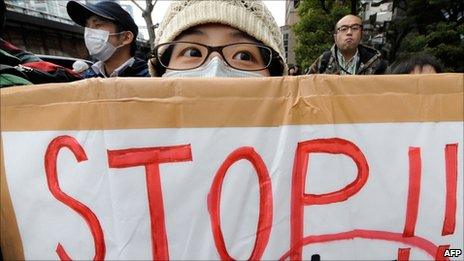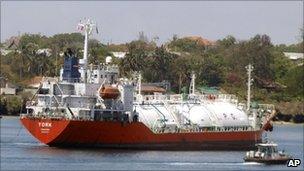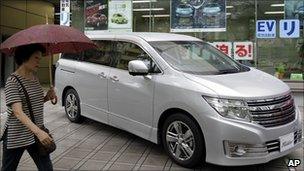Companies that gain from the Japanese quake
- Published

Plans to expand Japan's nuclear power capacity are now unlikely to go ahead
If stock markets do not like uncertainty, one would have imagined that the uncertain fate of a nuclear reactor in partial meltdown 220 km from the world's third largest stock market would have scared it witless.
But the immediate collapse of the market after the triple disasters of earthquake, tsunami and nuclear fall out was in fact followed by an optimistic bounce.
There are sound reasons for this, much of them to do with the certainty of reconstruction.
Leading the optimists are the firms that look likely to do the heavy lifting: Sumitomo Osaka Cement and Taiheiyo Cement rose 17% during March.
Equipment makers Komatsu, Mitsubishi and Kawasaki gained 10-12%.
Similar gains were seen in Oki Electric Cable, Showa Holdings and Totaku Electric.
All these company stand to benefit from the rebuilding of the electricity infrastructure.
Looming energy shortages
But the continuing crisis at the Fukushima Daiichi nuclear plant has two very destructive aspects.

Rising demand for liquefied natural gas tankers is pushing up prices
The first is the obvious danger of continuing radiation leaks.
The second is the closing of 11 nuclear power stations (there are 54 in total in Japan) and the part closure of several refineries resulting is a reduction in energy supply of over 10%.
This in turn is hampering the reconstruction process, as factories grind along at severely reduced capacity, hampered by power outages.
For Seijiro Takeshita, director of Mizuho Financial Group this is crucial.
"At the moment the energy supply is just short of demand and we can just cope, but in the summer the demand will rise by as much as 50, 60 even 70% and then we will be in real difficulty," he says.
Shipping gas
However unpalatable it may seem, one man's disaster is another man's opportunity.
Oil and coal will make up half the shortfall, but the remaining 50% is expected to come from Liquified Natural Gas, and the share prices of LNG producers have reflected that.
In Japan itself Showa Shell shares rose 13% in March. Woodside Petroleum of Australia gained 14% after the quake. BG in the UK saw its shares rise 7%.
And shipping LNG is getting expensive with capacity at close on 100%.
One analyst estimates rises in LNG shipping rates of around 60-70% by the year end.
LNG tankers are technically more complex to build than oil ones and almost twice the cost; any new orders will not be delivered for some four years or so.
Shares in LNG shippers Golar rose 26% in Oslo in March. Rivals Exmar and Teekay gained 15% and 6% respectively.
Solar panels
Even for those companies unable to export directly to shore up the Japanese electricity sector, there are benefits.
Russia's gas pipelines head largely westwards to Europe and its most lucrative export market slumped after the 2008 financial crisis as Europe's economies contracted and consumers switched to cheaper alternative supplies.
Now, Russia is negotiating extra sales westwards to make up for the European supplies that are heading east.
And for those fans of alternative energy, solar related companies are on the up too.
Showa Shell, as well as capitalising on fossil fuel needs, has developed the technology for manufacturing next-generation CIS thin-film solar panels.
Sharp and Kyocera both make solar cells and electronics and despite sharp falls after the disaster have recovered all their losses (the Nikkei recovered about a half its original falls by the end of March).
Nuclear shares

Japanese demand for solar panels is set to grow
And it seems in the face of nuclear disaster, worries about global warming take a back seat.
The Bloomberg American Coal Index, which charts the biggest coal companies in the US, has risen 14% since the day before the earthquake.
Nuclear energy shares have surprisingly not been as badly affected as might have been thought.
Certainly, Tokyo Electric shares have fallen by over three quarters and the company is now expected to be nationalised.
Only two months ago, the World Nuclear Association was cheerfully predicting a 40% increase in Japan's nuclear capacity by 2017.
That is unthinkable now.
However, shares in US utilities such as Exelon and Progress are holding up.
Shares in GE, which designed the Fukushima plant, fell just 3-4% from their pre-crisis price.
'Huge problems'
But the most far-reaching effect of the disaster is the damage to supply chains for Japanese, and the rest of the world's, manufacturing industries.

Carmakers and other manufacturers are suffering parts shortages
"We have become over-infected with optimism and faith in natural Japanese resilience," Sejeiro Takeshita explains.
"But there are two things that will stop us from recovering as fast as people hope. One is the electricity shortage, and the other is the cutting of the flow side - the distribution networks - in the areas affected by the disaster.
"We have prided ourselves on our just-in-time processes and not holding too much inventory. We have even got good risk management to cope with disasters - but really only disasters that last 72, or 84 hours.
"On this scale, where the flow cycle is truncated so severely, we have huge problems."
Devastating impacts
That is why it is not just production at car companies such as Toyota and Honda that is spluttering along like a truck with a faulty fuel line.
Ford is partly closing its Genk production facility because of a shortage of Japanese parts. GM is having problems sourcing supplies for its vehicles. Honda has halved its output in the UK.
More shortages are expected to develop in the coming weeks particularly for high volume manufacturers such as Nokia.
As Sejeiro Takeshita points out, if a component company in Japan has, say, a 50% market share for some small component, production halts can have devastating impacts on the end product.
It could well create competitive advantages for companies outside the Japanese supply chain.
The effects of this disaster are only beginning to unfold.